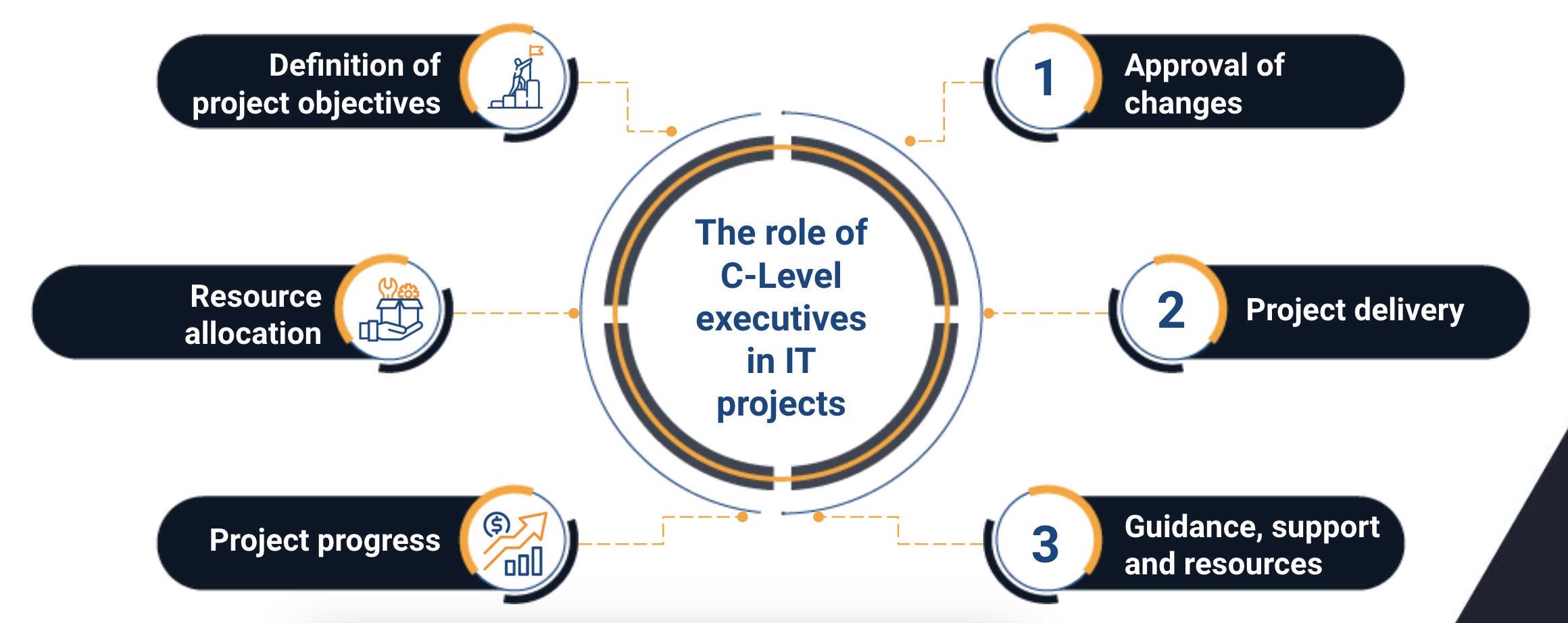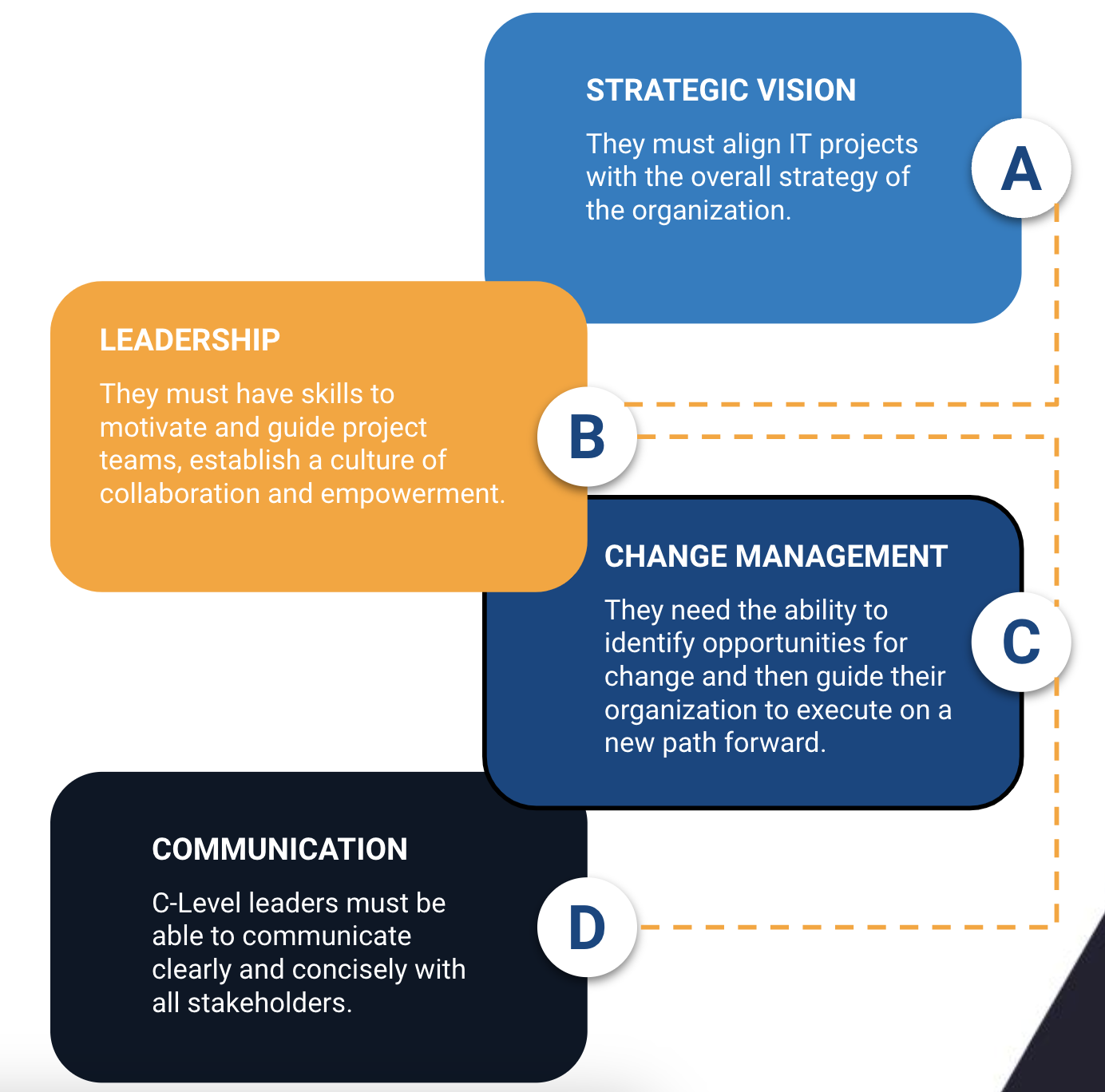
IT projects are known for their demanding and challenging nature. From conception to implementation, these projects require careful planning and execution to prevent them from becoming a mess. C-Level executives play a critical role in this process, as they must have a clear understanding of what they want to achieve with the project.
First, IT projects often involve a wide range of technologies and complex systems. C-Level executives must have a clear vision of the objectives and expected results of the project from the beginning. This implies clearly defining the requirements and scope of the project, establishing realistic goals and deadlines. Without clear direction, the project can easily drift off course and create confusion among work teams.
Also, IT projects often have multiple stakeholders and multidisciplinary teams involved. Each of these groups may have different expectations and priorities and it is the responsibility of executives to effectively coordinate and communicate with all stakeholders to ensure a common understanding of the project. This involves establishing clear and open communication, fostering collaboration, and resolving potential conflicts as they arise.
In this article we will address precisely this topic: how C-Level executives can best manage the development of IT projects, through different tools and strategies.

What do C-Level executives do?
C-Level executives have specific responsibilities that contribute to successful IT project management. We will detail some below:
CEO (Chief Executive Officer):
"Decisions about new product lines, the generation (and/or maintenance) of competitive advantages, new potential markets and the mitigation of risks or the use of opportunities (among others) fall under the competence of the CEO", comment in an article from the Corporate Finance Institute portal.
“The CEO is responsible for the success or failure of the organization, overseeing the entire operation at a high level. The CEO implements plans and policies to ensure the successful management of the business and establishes future strategies”, they added in another article on the Tech Target portal.
CIO (Chief Information Officer):
The CIO's role is to oversee and manage a company's IT infrastructure and operations. They use technological systems and products in order to streamline internal business processes. Its main objective is to optimize efficiency and daily productivity within the company, either by automating complex tasks or facilitating more fluid communication between different departments.
“Monitors the people, processes, and technologies within a company's IT organization to ensure that they deliver results that support business objectives”, Gartner detailed.
CTO (Chief Technology Officer):
CTOs are responsible for developing technology products or services that meet customer needs. The role of a CTO involves continually researching cutting-edge solutions to improve the company's products or services, explained in Workable.
They also oversee engineers and developers tasked with designing the products or services, and assess both their appeal and functionality in the final versions.
“A CTO is a cross between an IT professional and an executive, so they should have complementary skills in both areas”, they noted in a Business News Daily article.

The role of C-Level executives in IT projects
C-Level executives play an important role in IT projects. They are responsible for ensuring that projects are aligned with business objectives, that adequate resources are available, and that deadlines are met. They must also provide guidance and support to the project team.
The following are some of the key roles C-Level executives play in IT projects:
- Definition of project objectives
C-Level executives must work with the project team to define the objectives of the project. These objectives must be specific, measurable, achievable, relevant and timely.
- Resource allocation
C-Level executives must allocate the necessary resources to the project. This includes personnel, time, money, and technology.
- Track project progress
C-Level executives must track the progress of the project to ensure that the plan is being followed through. They must also identify any potential problems and take corrective action.
- Approval of changes
C-Level executives must approve any changes to the project. This includes changes to scope, schedule, or budget.
- Project delivery
C-Level executives must ensure that the project is delivered on time, on budget, and as specified.

C-Level executives may also fill other roles on IT projects, depending on the specific needs of the project. For example, they may provide guidance on the company's technology strategy, or they may help market project results to clients.
The role of C-Level executives in IT projects is critical to the success of the project. By providing guidance, support, and resources, C-Level executives can help ensure projects are completed on time, on budget, and as specified.
Key skills and competencies that C-Level leaders must have to manage IT projects effectively
To manage IT projects effectively, C-Level leaders must possess a number of key skills and competencies. Here are some of them:
Strategic vision
C-Level leaders must have a clear and strategic vision for IT projects. They must understand how technology can drive business objectives and align IT projects with the organization's overall strategy.
Technological knowledge
It is critical that C-Level leaders have a strong technological background. They must stay up to date on technological trends and advancements relevant to the project, understand the implications and benefits of technology, and make informed decisions.
Leadership skills
C-Level leaders must be excellent leaders. They must have the skills to motivate and guide project teams, establish a culture of collaboration and empowerment, and communicate effectively with all stakeholders, both internal and external.
"Personality. Diligence. Modesty. Knowledge. The ability to inspire. What do these character traits have in common? All are traits that are consistent among great leaders. If a candidate has all these characteristics, it is likely that he can lead a C-level position”, they emphasized in an article in Inc.

Change management
Change management is essential in IT projects, as they often involve changes in processes, organizational structures and corporate culture. C-Level leaders must have skills in managing and mitigating resistance to change, communicating benefits, and managing stakeholder expectations.
“Change management is an increasingly important skill among senior leaders. They need the ability to identify opportunities for change and then guide their organization to execute on a new path forward. An often overlooked part of the executive skill set, learning about change management can be a major differentiator for leaders", they narrowed down in an article from the University of Pennsylvania.
Strategic and analytical thinking
C-Level leaders must have analytical skills and the ability to think strategically. They must be able to analyze data and complex information, identify patterns and trends, and use that insight to make informed decisions and guide project direction.
Communication skills
Effective communication is critical in IT project management. C-Level Leaders must be able to communicate clearly and concisely with all stakeholders, including team members, organization executives, and outside vendors. They must also be good listeners and encourage open and transparent communication.
“They need to be able to converse with people at all levels of an organization. This includes presentation skills beyond a meeting with colleagues. Persuasion and influence are powerful skills for any executive and must be reflected in all aspects of communication," they added in the same article from the University of Pennsylvania.
Customer orientation
C-Level leaders must be customer oriented and focused on delivering solutions that meet the needs and expectations of customers and end users. They must understand the customer's needs and ensure that the IT project is aligned with those needs.

Final Recommendations for C-Level Leaders in IT Project Management
C-Level leaders are responsible for defining the organization's strategy and vision, as well as aligning resources and objectives with business needs. In the field of IT projects, this implies having a clear vision of the priorities, benefits and risks of each initiative, as well as the skills and competencies necessary to execute them successfully.
Some final recommendations for C-Level leaders in IT project management are:
- Establish effective governance that engages key stakeholders, both internal and external, and ensures timely and data-based communication, monitoring, and decision-making.
- Define the success criteria and performance indicators for each project, as well as the evaluation and control mechanisms that allow measuring the progress and impact of the implemented solutions.
- Promote a culture of innovation and continuous learning that encourages experimentation, feedback and constant improvement, as well as adaptation to change and solving complex problems.
- Support the development and retention of human talent, recognizing the value of people as the most important asset of the organization and providing the conditions, incentives and opportunities for their professional and personal growth.
- Take advantage of agile methodologies and digital tools that facilitate collaboration, transparency and the delivery of value to the client quickly and efficiently.
WE RECOMMEND YOU this VIDEO

